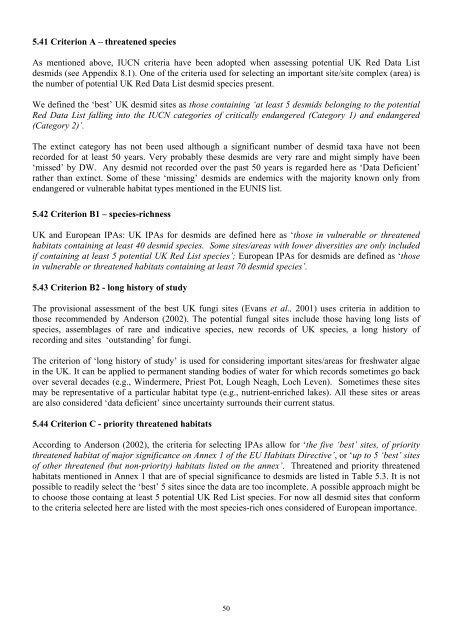Important Plant Areas for algae - Natural History Museum
Important Plant Areas for algae - Natural History Museum
Important Plant Areas for algae - Natural History Museum
Create successful ePaper yourself
Turn your PDF publications into a flip-book with our unique Google optimized e-Paper software.
5.41 Criterion A – threatened species<br />
As mentioned above, IUCN criteria have been adopted when assessing potential UK Red Data List<br />
desmids (see Appendix 8.1). One of the criteria used <strong>for</strong> selecting an important site/site complex (area) is<br />
the number of potential UK Red Data List desmid species present.<br />
We defined the ‘best’ UK desmid sites as those containing ‘at least 5 desmids belonging to the potential<br />
Red Data List falling into the IUCN categories of critically endangered (Category 1) and endangered<br />
(Category 2)’.<br />
The extinct category has not been used although a significant number of desmid taxa have not been<br />
recorded <strong>for</strong> at least 50 years. Very probably these desmids are very rare and might simply have been<br />
‘missed’ by DW. Any desmid not recorded over the past 50 years is regarded here as ‘Data Deficient’<br />
rather than extinct. Some of these ‘missing’ desmids are endemics with the majority known only from<br />
endangered or vulnerable habitat types mentioned in the EUNIS list.<br />
5.42 Criterion B1 – species-richness<br />
UK and European IPAs: UK IPAs <strong>for</strong> desmids are defined here as ‘those in vulnerable or threatened<br />
habitats containing at least 40 desmid species. Some sites/areas with lower diversities are only included<br />
if containing at least 5 potential UK Red List species’; European IPAs <strong>for</strong> desmids are defined as ‘those<br />
in vulnerable or threatened habitats containing at least 70 desmid species’.<br />
5.43 Criterion B2 - long history of study<br />
The provisional assessment of the best UK fungi sites (Evans et al., 2001) uses criteria in addition to<br />
those recommended by Anderson (2002). The potential fungal sites include those having long lists of<br />
species, assemblages of rare and indicative species, new records of UK species, a long history of<br />
recording and sites ‘outstanding’ <strong>for</strong> fungi.<br />
The criterion of ‘long history of study’ is used <strong>for</strong> considering important sites/areas <strong>for</strong> freshwater <strong>algae</strong><br />
in the UK. It can be applied to permanent standing bodies of water <strong>for</strong> which records sometimes go back<br />
over several decades (e.g., Windermere, Priest Pot, Lough Neagh, Loch Leven). Sometimes these sites<br />
may be representative of a particular habitat type (e.g., nutrient-enriched lakes). All these sites or areas<br />
are also considered ‘data deficient’ since uncertainty surrounds their current status.<br />
5.44 Criterion C - priority threatened habitats<br />
According to Anderson (2002), the criteria <strong>for</strong> selecting IPAs allow <strong>for</strong> ‘the five ‘best’ sites, of priority<br />
threatened habitat of major significance on Annex 1 of the EU Habitats Directive’, or ‘up to 5 ‘best’ sites<br />
of other threatened (but non-priority) habitats listed on the annex’. Threatened and priority threatened<br />
habitats mentioned in Annex 1 that are of special significance to desmids are listed in Table 5.3. It is not<br />
possible to readily select the ‘best’ 5 sites since the data are too incomplete. A possible approach might be<br />
to choose those containg at least 5 potential UK Red List species. For now all desmid sites that con<strong>for</strong>m<br />
to the criteria selected here are listed with the most species-rich ones considered of European importance.<br />
50

















